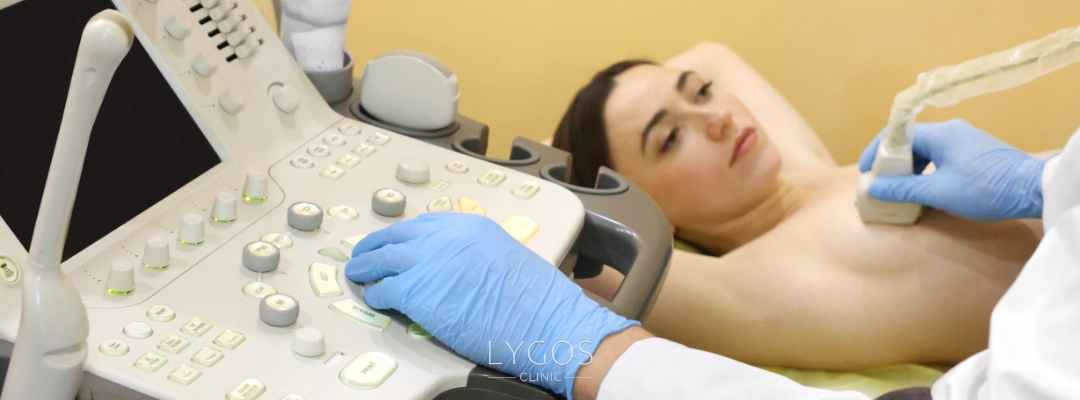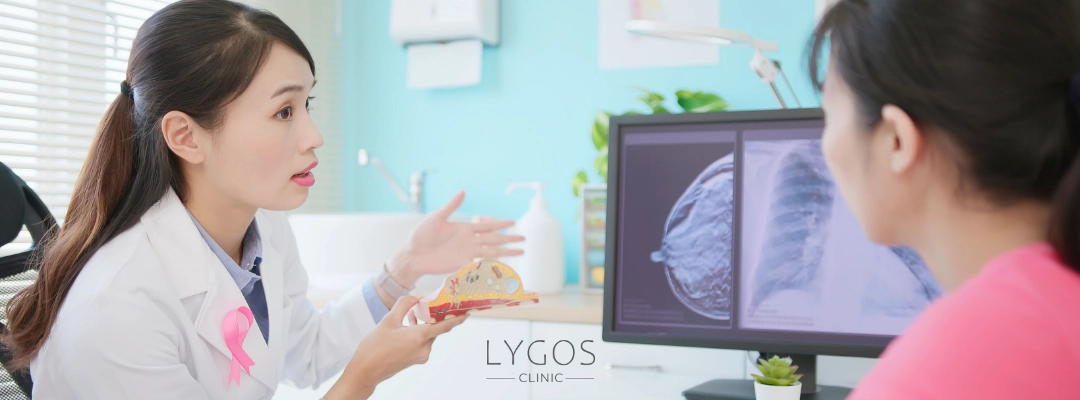Breast Lump | Types: Benign, Malign and Causes | LYGOS 2025

Breast Lump
While cancer stands out as one of the most common health problems today, early diagnosis rates are also increasing thanks to the awareness of the society on this issue. Breast cancer, which is the most common type of cancer among women, can be treated more easily, especially with symptoms recognized in the early stages. A mass in the breast can be an important sign of breast cancer, but it can also be an indicator of benign non-cancerous breast diseases.
Therefore, it is of great importance that every woman has the right information about breast lumps. This awareness is critical for early diagnosis and correct intervention, because not every lump in the breast is cancerous. However, taking such changes into account enables people to take more conscious steps to protect their health. So, what are breast lumps and what are the symptoms of breast lumps? You can find the details in our article.
What are Breast Lumps?

Breast tissue has a complex structure consisting of milk glands and their ducts located in connective tissue and adipose tissue attached to the chest wall. Therefore, any mass formation felt in the breast can be caused by glands, ducts, adipose tissue or connective tissue. The fact that the hormonal structure of women has a great effect on breast tissue causes changes in hormone levels in the blood to cause changes in breast tissue. These hormonal fluctuations can sometimes lead to the formation of mass structures in the breast.
A breast lump is a condition that occurs when the tissues in the breast grow unusually large. The lumps can be hard or soft and can range in size from a few millimeters to several centimeters. Although breast lumps can be a sign of cancer, not all lumps are cancerous. Many breast lumps can also be caused by benign tumors. Therefore, it is extremely important to consult a specialist immediately in case of any lump in the breast and to have the necessary medical examinations.
What are the Symptoms of Breast Lumps?

It is very important for women to examine themselves regularly after puberty to detect breast cancer early. After the age of 40, regular mammography every year is a recommended screening method to reduce the risk of breast cancer. Some symptoms noticed during the examination can be vital for early diagnosis. In particular, masses felt in the following cases should be evaluated by a specialist doctor. Symptoms of breast lumps are as follows:
- Masses that cause changes in breast shape, color or skin structure
- Masses associated with nipple displacement, deformity or bloody discharge
- Masses that increase in size or change in shape
- Masses that do not regress after menstruation
- Hard, irregular, limited and immobile masses
- Any newly detected mass
- Early detection of breast mass symptoms can play a critical role in the treatment of breast cancer.
What Causes Breast Lumps?

Masses felt in the breast can be a symptom of various disorders caused by different types of tissue. Such lesions can be associated with both benign and serious conditions. So, what causes breast lumps?
Simple Cysts:
Masses that are smoothly circumscribed, soft and mobile in nature usually indicate simple cysts. Simple cysts are fluid-filled structures formed by the filling and swelling of the glands in the breast tissue. They are usually harmless and are one of the most common benign breast lesions.
Milk Cysts:
Milk cysts seen in breastfeeding women are formed as a result of milk accumulation in the breast tissue. It has a similar structure to simple cysts and can be felt as a mass during this period.
Fibrocystic Disease:
Breast tissue can grow and develop due to hormone fluctuations during the menstrual cycle of women. In women who experience hormonal irregularities, this growth can become irregular and cause benign masses called fibrocystic disease. These lesions, which are common in young women, do not become cancerous and usually vary depending on the menstrual cycle.
Fibroadenoma:
Lesions called fibroadenomas occur as a result of the organized growth of connective tissues that make up the breast tissue. These structures, usually seen in women in their 20s, are smoothly circumscribed, rubbery and mobile. Fibroadenomas rarely develop into cancer and are usually harmless.
Intraductal Papilloma:
Intraductal papillomas, which develop in the ducts connecting the glands to the nipple, are benign formations that can be felt as a mass. They often develop in a single secretory duct and may cause bloody discharge. Although rare, they carry a risk of cancer.
Post Traumatic Fat Necrosis:
Trauma to the breast tissue can cause damage to the fatty tissue, which can lead to mass-like lesions. Fat necrosis is usually benign, but it can feel like a mass and should therefore be carefully examined.
Breast Cancer:
Irregularly circumscribed, hard and immobile masses may be a sign of breast cancer. Lesions detected in the early stages of breast cancer offer the chance of successful treatment. In advanced stages, the mass may grow and spread to lymph nodes or vascular structures. Cancer-related masses are often accompanied by additional symptoms such as breast shape distortion, nipple displacement and skin changes.
Abscess:
Especially in breastfeeding women, an abscess may develop due to inflammation of the breast tissue. This inflammation, known as mastitis, may present with symptoms such as pain, tenderness and increased temperature in addition to the mass. Masses felt in the breast should be taken seriously and evaluated by a specialist physician. Although many masses are benign, early diagnosis can be life-saving, especially in cases such as breast cancer.
Which Breast Lump is Dangerous?

In the evaluation of breast lumps, the physical characteristics of the lumps provide important clues. If the patient feels a lump with a smooth and even surface and if the lump can move like a marble in the breast, this usually indicates a benign structure. On the other hand, if the lump has an irregular surface and is immobile, this may be a symptom that increases the likelihood of cancer. The characteristics of such masses play a critical role in diagnosing cancer. Therefore, it is extremely important to consult a specialist physician and undergo the necessary tests if any abnormality is felt.
Treatment of Breast Lumps

The treatment of breast lumps may differ for each case and intervention may not be required for every lesion. Depending on the type and size of the lesions, its impact on the patient’s quality of life, detailed examinations and diagnostic results, a treatment plan is created. there is more than one method for the treatment of breast lumps.
Benign Lesions:
In benign cases, such as simple cysts or fibrocystic disease, intervention only becomes necessary if it negatively affects the patient’s daily life. Small and uncomfortable cysts are usually monitored. However, large cysts that cause discomfort may require needle aspiration of fluid or surgical intervention.
Lesions with Cancer Risk:
For masses that have the potential to become cancerous, treatment varies depending on the size and clinical condition of the lesion. In this case, complete removal of the mass or removal of some of the breast tissue may be considered.
There are various treatment options for lesions diagnosed as breast cancer. These treatment methods are determined according to the characteristics, size and spread of the mass. One or more of the following breast mass treatment methods can be applied:
Lumpectomy:
It is the process of removing only the cancerous mass and the surrounding healthy tissues. It aims to preserve breast tissue.
Mastectomy:
It is the complete removal of the breast. The physician and the patient can decide together whether to preserve the nipple by deciding on breast-conserving surgery.
Removal of lymph nodes:
In case the cancer has spread, the affected lymph nodes may be removed. This is important to assess the spread of the disease.
Radiotherapy:
Radiation therapy can be used as an additional treatment for women who have undergone breast-conserving surgery. This method reduces the likelihood of cancer cells recurring.
Chemotherapy:
Depending on the characteristics of the mass, hormone therapy, biological agents or chemical treatment may be used. Chemotherapy aims to stop the growth of cancer cells.
As a result, breast lump treatment requires a customized approach for each individual. With early diagnosis and appropriate treatment options, patients can improve their quality of life and lead a healthy life. Therefore, it is of utmost importance to consult a specialist in case of any felt lump in the breast.
Breast Lumps Treatment Costs
Breast lumps treatment costs vary according to the needs of the patient and the method to be used. In addition, the experience of the doctor who will perform the procedure and the equipment of the hospital also affect the costs. Therefore, it may be misleading to give a clear figure about the breast lumps treatment costs.
| Breast Lump Treatment Countries | Prices |
|---|---|
| Turkey Breast Lump Treatment Costs | $750 – $1,750 |
| UK Breast Lump Treatment Costs | $1,150 – $2,850 |
| United States Breast Lump Treatment Costs | $1,550 – $3,950 |
| Germany Breast Lump Treatment Costs | $2,250 – $5,400 |
| Spain Breast Lump Treatment Costs | $2,900 – $6,800 |
| France Breast Lump Treatment Costs | $3,200 – $7,500 |
| Italy Breast Lump Treatment Costs | $3,550 – $8,750 |



